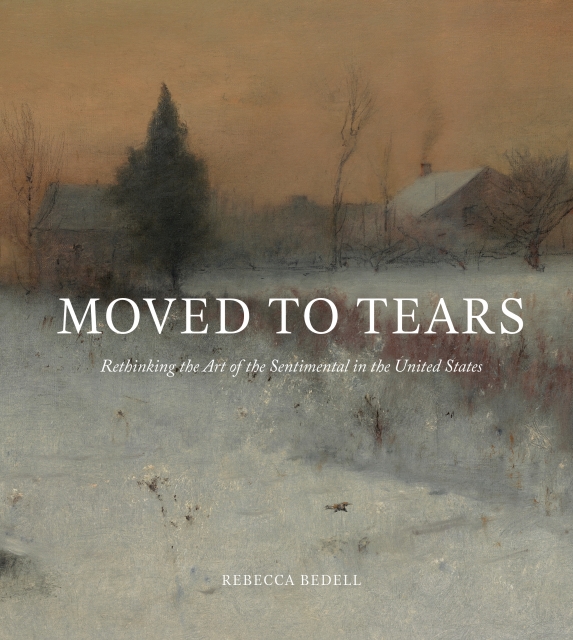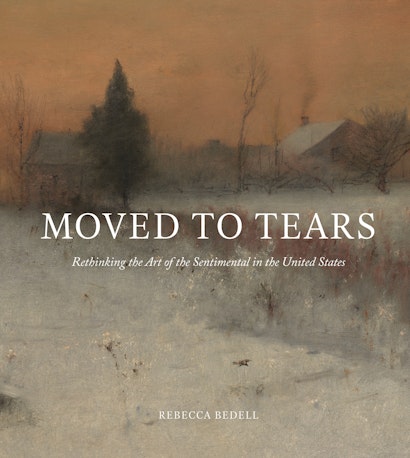In her new book Moved to Tears, Rebecca Bedell overturns received ideas about sentimental art, arguing that major American artists—from John Trumbull and Charles Willson Peale in the eighteenth century and Asher Durand and Winslow Homer in the nineteenth to Henry Ossawa Tanner and Frank Lloyd Wright in the early twentieth—produced what was understood in their time as sentimental art. This was art intended to develop empathetic bonds and to express or elicit social affections, including sympathy, compassion, nostalgia, and patriotism. In this Q&A, she discusses the ways sentimental art has been misunderstood, and why it is important today.
What is new in the book? What did you hope to accomplish?
RB: I hope both to uproot the still tenacious modernist prejudice against sentimental art and to transform our understanding of it. So many art critics, art historians, artists, and others regard “sentimental art” as a synonym for “bad art.” I want to redefine and complicate ideas about sentimental art: what it looks like, who made it, the cultural work it does.
Isn’t there bad sentimental art?
RB: Yes, of course. There’s also bad abstract art, bad Impressionist art, bad portraits—but we don’t dismiss those entire categories of art because of that.
I associate sentimental art with Victorian genre painting. Is that what you focus on?
RB: No. I do not associate sentimental art with particular subject matter, nor do I locate it in the Victorian era alone. I’ve tried to suggest in the book the extent to which the sentimental pervaded artistic production (and reception) from the later eighteenth century onward. It touched nearly all categories of subject matter: portraits, history painting, religious imagery, landscape, and so on. It affected the creation not only of painting, sculpture, prints, and photography, but also architecture, landscape design, and public spectacles.
Who are the key figures in the book?
RB: The artists I address range from John Trumbull and Charles Willson Peale in the late eighteenth century, to Andrew Jackson Downing, Thomas Cole, Winslow Homer, Mary Cassatt, John Singer Sargent, and others in the nineteenth, to Henry Ossawa Tanner and Frank Lloyd Wright in the early twentieth.
So, what is sentimental art?
RB: Sentimental art has fundamentally to do with connectedness, with our connectedness to others, to place, to the conditions of our existence. Sentimental art aims to develop empathetic bonds and to represent and elicit what were called in the eighteenth century the “social affections,” those emotions that bind us together, including tenderness, affection, sympathy, compassion, and patriotism. I see sentimental art as part of the broader “sentimental project,” as historians have termed it, launched from Great Britain in the eighteenth century. Its ambition was to transform individuals and society through the cultivation of sympathy. Abolitionism, penal reform, child labor laws, and societies for the prevention of cruelty to animals were all, in some measure, parts of the project.
In working on the book, did you come upon anything that surprised you?
RB: I began the project by combing through eighteenth- and nineteenth-century books, newspapers, and magazines for the use of the word “sentimental” in relation to art. The first instance I found of this was a surprise to me. A writer for a Boston newspaper in the 1780s described John Trumbull’s Revolutionary War paintings as sentimental, and in a very positive way. That was my first hint that sentimental art’s early associations were not with the feminine and the domestic, but with the masculine, the public, and the political.
Where did the book begin? What launched you on this project?
RB: As an art historian and teacher, I have been thinking about these issues and themes for a long time. But in a way, this project began in a big way for me during Barack Obama’s presidency, when he was selecting a new Supreme Court justice. He said that one of the qualities that he valued in jurists was empathy. The backlash against that statement was so intense and powerful that it shocked me. To me, empathy, an ability to think oneself into the subject position of someone different from oneself, seems a critically important quality in a judge. Where did this angry, visceral reaction against the connective emotions of the sentimental come from? At the same time, in my readings in my field of American art, I was continually coming upon statements such as, “Winslow Homer was never sentimental,” “John Singer Sargent’s paintings of children are never sentimental.” Yet their works—at least some of them—looked sentimental to me. Why this need to deny the presence of the sentimental in the works of artists we admire? All of this came together to launch me on this project. I had become conscious of a broad societal aversion to and rejection of the sentimental in both art and public life, and I wanted to understand it historically. What caused this aversion? Where did it come from? When did it begin?
Is sentimental art still being made today?
RB: Certainly. Steven Spielberg is one of the great sentimental filmmakers of our time. Ken Burns too. Much of the environmental art being created today is deeply concerned with our connectedness to the natural world. Some of the most powerful art associated with the Black Lives Matter movement, such as Carrie Mae Weems’s recent work, is, in my understanding of the term, sentimental. In fact, I think it is difficult to identify any artists whose work excludes the sentimental completely. Its emotions—compassion, sympathy, affection, pity, concern—are fundamental to our human identities. I don’t think they can ever be wholly suppressed, and indeed one of my discoveries in my research and writing is that the sentimental is at the core of much of the art we admire and enjoy the most.
Rebecca Bedell is associate professor of art and chair of the Art Department at Wellesley College. She is the author of The Anatomy of Nature: Geology and American Landscape Painting, 1825–1875 (Princeton). She lives in Cambridge, Massachusetts.

